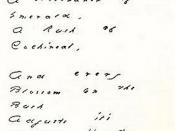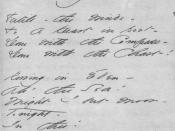Emily Dickinson wrote a highly characteristic poetry on the joy and pain of existence. Her poetry is compressed, sharp, but sometimes ambiguous. It is very interesting because she exploits the potentialities of the form as much as the capacities of the semantics. In "After Great Pain, A Formal Feeling Comes", one of her definition poems, she refers to nerves sitting like tombs and uses "Hour of Lead" and "Quartz contentment" as metaphors of special awareness of emotional hurt. This poem is obviously an attempt to communicate to the reader the nature of the experience, which comes "after great pain". It describes the stages undergone by a person who has experienced great pain and suffering, showing at the same time the relationship between psychic trauma and external conditions, such as time and space. The poet uses tropes and figures for depicting this pain, which is obviously not a physical pain; it is some great sorrow or mental pain, which leaves the mind numbed.
We will also see that this experience of pain and suffering can be related to death and immortality.
Dickinson brilliantly recreates the suffering we undergo after some terrible event in our lives. The specific cause of the torment does not matter; whatever the cause, the response is the same, and, in this poem, the response is what matters. The experience is one that all of us will undoubtedly endure at some time or other and may be one you have already endured. The poem does not say of what pain or whose feeling it is, rather, it tells of how the nerves sit, how the heart questions, how the feet go round. It speaks of ceremonies, tombs, ground, air, ought, quartz, stone, contentment, lead, and the snow. It would be absurd to try to distinguish as a physical...


